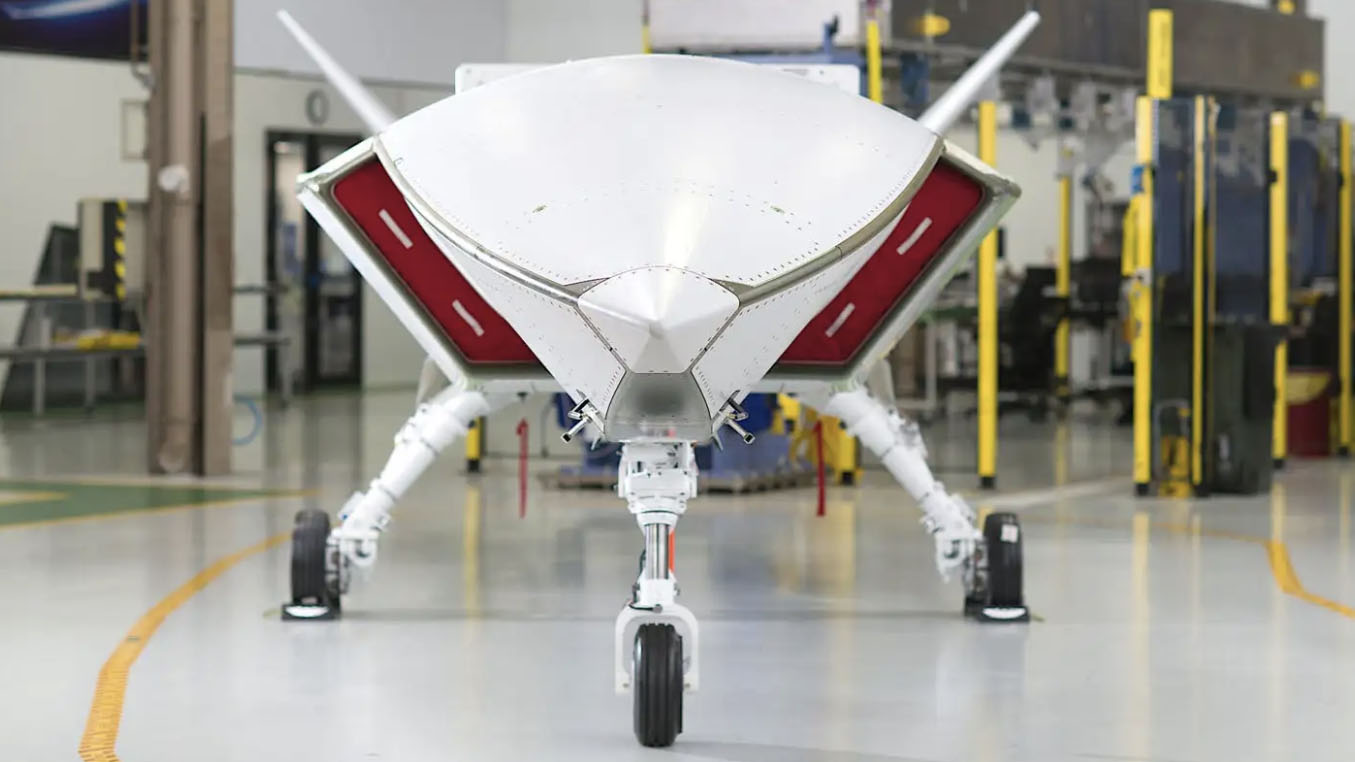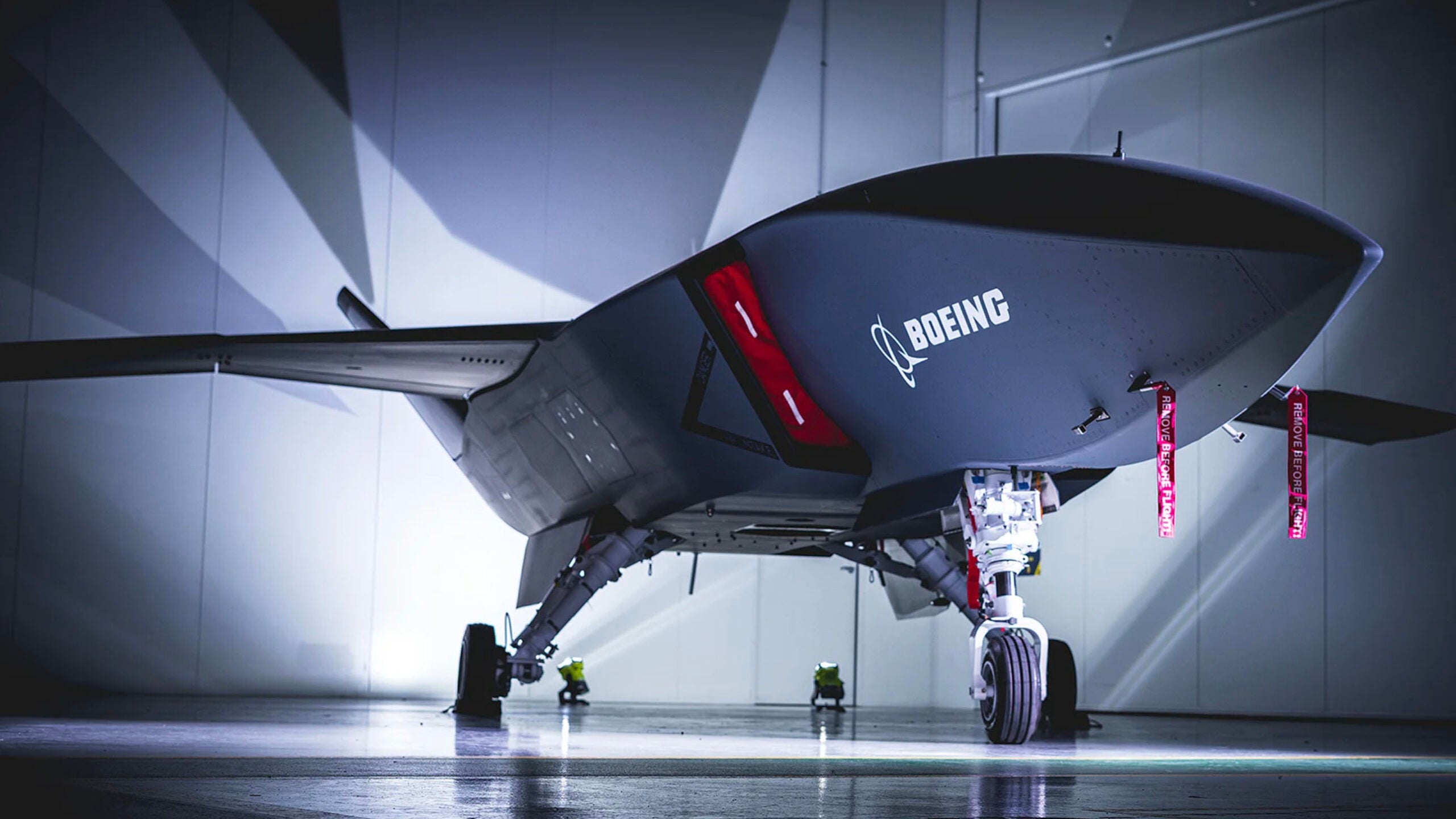One of Boeing’s prototype loyal wingman-type drones for Australia — a unique Australian Ministry of Defense and Boeing Australia project — has been spotted out in the open for the first time. Captured at an undisclosed location in the Australian state of Queensland, the long-lens imagery provides us with a glimpse of the pre-production unmanned teaming aircraft “in the wild.”
The work of an anonymous photographer, the two images — taken earlier this month — were published by Australian Defence Magazine. Although distorted by heat haze, they show the drone on an airfield “somewhere in Queensland.” Exactly where the three pre-production unmanned teaming aircraft are being built has not been announced, but it’s known to be in Queensland, a state that’s also home to the headquarters of Boeing Defence Australia, which is located in Brisbane.
Queensland is also home to Royal Australian Air Force (RAAF) Base Amberley. The RAAF’s F/A-18F Super Hornet and EA-18G Growler combat jet fleets operate from that base, as do heavy transports and tankers.
The drone seen in the two photos has a general shape and size that is in line with images and information that Boeing has already released itself. The company previously said that the single-engined loyal wingman unmanned aircraft is 38 feet long, with a wingspan of 24 feet. This makes it around 10 feet shorter than the U.S. Air Force’s T-38 Talon trainer, and its fairly diminutive proportions are emphasized by the small airport tractor pulling it in one of the pictures from Queensland.
What appears to be a white antenna, which has not been seen in previous Boeing pictures or concept art, is visible on top of the rear fuselage. This could be associated with some sort of test equipment.

Not only is this loyal wingman program the first time Boeing has created a clean-sheet design outside the United States, but the resulting vehicle is the first new Australian military aircraft to emerge in over half a century. You can read all about the drone in this previous War Zone article, including insight from senior officials involved in its development.
With a first flight due to take place before the end of the year, it seems logical that the latest photos show the combat drone undertaking taxi trials — or being made ready to commence them. This could be a prelude to being air-transported to another location for a maiden flight. While it’s not been announced where the Loyal Wingman will actually take to the air, one option is Woomera in South Australia, a secretive and secluded test facility with a long history of unmanned aerial vehicle and missile trials. Currently, the base’s website lists exclusion areas set up in two different areas of the range from Nov. 5 to Dec. 9, 2020, and from Nov. 19 to Dec. 9, 2020.
While popularly known as the Loyal Wingman in Australia, the vehicle spotted in Queensland is more properly the Loyal Wingman — Advanced Development Program, the centerpiece of the larger Airpower Teaming System (ATS) project. Once operational, this cutting-edge drone will be expected to take on a range of different functions, including working alongside fighters, tankers, maritime patrol aircraft, and even airborne early warning and control platforms. The cornerstone of the concept is a low-cost unmanned platform to work alongside traditional manned combat aircraft and operate as a force-multiplier, adding “mass” while also undertaking more hazardous tasks and missions when required. It’s a concept that The War Zone has previously discussed in detail here.

A key feature of the ATS air vehicle is its modular design, which promises to make it easier to expand and improve its capabilities. For instance, the airframe’s “snap-off” nose section can be rapidly switched between missions to provide the required capabilities. Thanks to an open architecture approach to the system, there is potential for different operators of the aircraft to tailor their own mission payloads that will be carried in the nose. You can read more about these design features in our previous analysis of the ATS.
The ATS is being developed in Australia by Boeing’s Autonomous Systems division and the firm’s Phantom Works International. As part of the research and development program, Boeing and the Australian government are building these initial drones as concept demonstrators prior to launching production of the ATS, which will serve the RAAF, as well as be made available for export. Because this is a strictly Australian project, the arrangement circumvents U.S. restrictions on exports of these types of highly sophisticated unmanned systems.
In all, 16 Australian firms are taking part in the rapid development effort, including BAE Systems Australia (flight control computers and navigation equipment), RUAG Australia (landing gear system), Ferra Engineering (precision machine components and subassemblies), and AME Systems (wiring looms).

The development program has moved along at a notably quick pace since the ATS was first announced in February 2019. Boeing officially rolled out the first of the three pre-production drones last May. So far, the program has also included Boeing Australia flying sub-scale demonstrators to prove the software and concepts of operation.
At the same time, of course, the U.S. Air Force is accelerating its own low-cost loyal wingman initiative, the Skyborg program, which you can read about here.
The latest unofficial images of the Australian Loyal Wingman show that the program is continuing to make impressive progress. All of this is building up to a first flight before the end of the year, after which we should learn even more about the capabilities of this enigmatic aircraft.
Contact the author: thomas@thedrive.com
